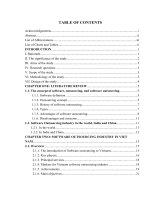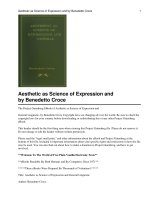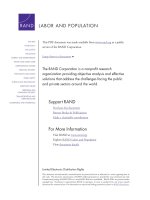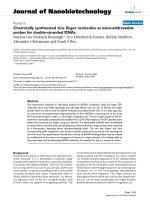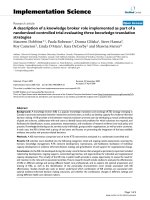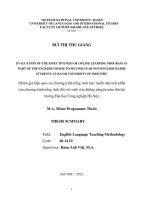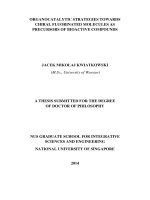Organocatalytic strategies towards chiral fluorinated molecules as precursors of bioactive compounds
Bạn đang xem bản rút gọn của tài liệu. Xem và tải ngay bản đầy đủ của tài liệu tại đây (10.72 MB, 258 trang )
ORGANOCATALYTIC STRATEGIES TOWARDS
CHIRAL FLUORINATED MOLECULES AS
PRECURSORS OF BIOACTIVE COMPOUNDS
JACEK MIKOŁAJ KWIATKOWSKI
(M.Sc., University of Warsaw)
A THESIS SUBMITTED FOR THE DEGREE
OF DOCTOR OF PHILOSOPHY
NUS GRADUATE SCHOOL FOR INTEGRATIVE
SCIENCES AND ENGINEERING
NATIONAL UNIVERSITY OF SINGAPORE
2014
II
I hereby declare that this thesis is my original work and it has been written by me in its
entirety. I have duly acknowledged all the sources of information which have been used in the
thesis. This thesis has not been submitted for any degree in any university previously.
The content of the thesis has been partly published in:
1. Xiao Han, Jacek Kwiatkowski, Feng Xue, Kuo-Wei Huang, Yixin Lu “Asymmetric
Mannich Reaction of Fluorinated Ketoesters with a Tryptophan-Derived Bifunctional
Thiourea Catalyst”, Angew. Chem. Int. Ed., 2009, 48, 7604.
2. Jacek Kwiatkowski, Yixin Lu “Highly Enantioselective Preparation of Fluorinated
Phosphonates by Michael Addition of α-Fluoro-β-ketophosphonates to Nitroalkenes”,
Asian J.O.C., 2013, Early View, DOI 10.1002/ajoc.201300211.
Pending submissions:
3. Jacek Kwiatkowski, Yixin Lu “Organocatalytic Michael Addition of -Fluoro--nitro
Benzyls to Nitroalkenes: Facile Preparation of Fluorinated Amines and Pyrimidines”.
4. Jacek Kwiatkowski, Yixin Lu “Towards the Enantioselective Synthesis of Divergent
and Functionalised -Fluoro--amino acids: Organocatalytic Michael
Addition/hydrogenation of Ethyl Fluoronitroacetate”.
Jacek Mikołaj Kwiatkowski
8 IV 2014
Name
Signature
Date
III
Acknowledgements
Research behind this thesis was done in Professor Lu Yixin‟s laboratory to whom I owe a
huge debt of gratitude for opportunities given, patience, support, guidance and constructive
critique. I would like to thank Prof. Christina Chai, Prof. Lam Yulin and Prof. Yao Shao Qin
for their vital advice and encouragement during our thesis advisory committee meetings. My
sincere “Thank You” to Prof. Phillip K. Moore and all NGS staff for their understanding and
dedication. The generous financial assistance from NGS is also gratefully acknowledged.
To all the Lu lab members with whom I crossed my path, past and present, thank you
very much for you friendship, support and supply of green tea. You will not be forgotten. I
would like to especially mention Dr Luo Jie, Dr Han Xiaoyu, Dr Dou Xiaowei, Dr Han Xiao,
Dr Zhong Fangrui, Dr Liu Xiaoqian and Dr Vasudeva Rao Ghandi.
Last but not least, I would like to thank my mother and family for their unconditional
support, which made completion of this journey possible. My special thanks to my father,
academic himself, for his enthusiasm, inspiration and support and to my lovely wife Marsewi
for invaluable help and support.
IV
Table of Contents
Thesis Declaration II
Acknowledgements III
Table of Contents IV
Summary IX
List of Tables XI
List of Figures XII
List of Schemes XIV
List of Abbreviations XX
List of Publications XXII
I. Introduction: chiral organofluorine compounds
I-1.Importance of organofluorine in medicinal chemistry
I-1.1. Properties of fluorine atom and the CF bond
2
I-1.2. Altering characteristics of molecules by selective incorporation of
fluorine
4
I-2. Synthesis of chiral fluorinated molecules
I-2.1. Direct fluorination
12
I-2.1.1. Organocatalytic enantioselective fluorination
13
I-2.1.2. Transition metal-mediated enantioselective fluorination
24
I-2.2. Indirect fluorination
36
I-3. Summary
50
V
II. Research results
II-1. Towards the enantioselective synthesis of functionalized -fluoro--amino
acids: organocatalytic Michael addition/hydrogenation of ethyl
fluoronitroacetate
II-1.1. Introduction
55
II-1.2. Organocatalytic Michael addition of ethyl fluoronitroacetate to
nitroalkenes - reaction optimization
59
II-1.3. Scope of the reaction
63
II-1.4. Synthesis of -fluoro--amino acid
65
II-1.5. Denitration and decarboethoxylation of the Michael adduct
66
II-1.6. Summary and future perspectives
67
II-2. Organocatalytic Michael addition of -fluoro--nitro benzyls to
nitroalkenes: facile preparation of fluorinated amines and pyrimidines
II-2.1. Introduction
70
II-2.2. Organocatalytic Michael addition of -fluoro--nitro benzyls to
nitroalkenes: reaction optimization
74
II-2.3. Preparation of the substrates
76
II-2.4. Scope of the reaction and absolute configuration of the products
77
II-2.5. Reduction of the nitro groups and synthesis of tetrahydropyrimidine
80
II-2.6. Summary
82
II-3. Enantioselective synthesis of functionalized fluorinated phosphonates via
Michael addition of -fluoro--ketophosphonates to nitroalkenes
II-3.1. Introduction
83
II-3.2. Michael addition of -fluoro--ketophosphonates to nitroalkenes:
reaction optimization
85
II-3.3. Preparation of substrates
88
VI
II-3.4. Reaction scope and determination of absolute configuration
91
II-3.5. Preparation of -fluoro-pyrrolidine
93
II-3.6. Summary
95
II-4. Organocatalytic Michael addition of -fluoro--diketones to
nitroalkenes: towards fluoro-isosteres of glycerine
II-4.1. Introduction
97
II-4.2. Michael addition of 2-fluoro-1,3-diketones to nitroalkenes: reaction
optimization
100
II-4.3. Preparation of the substrates
104
II-4.4. Scope of the reaction
105
II-4.5. Preparation of the glycerin analogue and further manipulations of the
product
108
II-4.6. Summary and future perspective
110
II.5 Asymmetric Mannich reaction - towards fluorinated amino acids, lactones
and -lactams
II.5.1. Introduction: development of organocatalytic Mannich addition of -
fluoro--ketoester to N-Boc aldimines
112
II.5.2. Manipulation of Mannich addition product - preparation of -lactam and
lactone
114
II.5.3. Decarboxylation/asymmetric protonation of Mannich malonate addition
product
117
II.5.4. Summary
126
III. Conclusion and future perspectives
III.1. Summary
131
III.2. Preliminary results and future perspective: decarboxylative additions of
fluoromalonate halfester
134
VII
IV - Experimental
General information
141
IV-1. Towards the enantioselective synthesis of functionalized -fluoro--
amino acids: organocatalytic Michael addition/hydrogenation of ethyl
fluoronitroacetate
IV-1.1. Preparation of substrates
143
IV-1.2. Experimental procedure and the analytical data of the Michael reaction
products
144
IV-1.3. Catalytic hydrogenation and analytical data of -fluoro--amino ester
153
IV-1.4. Decarboethoxylation and analytical data of fluoro-dinitro compounds
154
IV-1.5. Denitration and analytical data of -fluoroesters
156
IV-1.6. X-ray crystallographic analysis and determination of configuration of
the products
157
IV-2. Organocatalytic Michael addition of -fluoro--nitro benzyls to
nitroalkenes: facile preparation of fluorinated amines and pyrimidines
IV-2.1. Preparation of substrates and analytical data of new -fluoro--
nitrobenzyls
159
IV-2.2. General procedure and analytical data of the Michael reaction products
161
IV-2.3. Catalytic hydrogenation and analytical data of fluoroamines
168
IV-2.4. Preparation of tetrahydropyrimidine and analytical data
170
IV-2.5. X-Ray Crystallographic analysis and determination of configurations of
products
171
IV-3. Enantioselective synthesis of functionalized fluorinated phosphonates via
Michael addition of -fluoro--ketophosphonates to nitroalkenes
IV-3.1. Preparation of substrates and analytical data
174
IV-3.2. Representative procedure for Michael addition
182
IV-3.3. Analytical data of the Michael reaction products
182
VIII
IV-3.4. Synthesis of -fluoro--hydroxy--nitro phosphonate
197
IV-3.5. Synthesis of fluorinated pyrrolidine
200
IV-3.6. X-Ray crystallographic analysis and determination of configurations of
products
203
IV-3.7. Determination of configuration of pyrrolidines
206
IV-4. Organocatalytic Michael addition of 2-fluoro-1,3-diketones to
nitroalkenes: towards fluoro-isosteres of glycerine
IV-4.1. General procedure and analytical data of the Michael reaction products
207
IV-4.2. Reduction and analytical data of fluoroglycerines
220
IV-5. Asymmetric Mannich reaction - towards fluorinated amino acids,
lactones and -lactams
IV-5.1. Preparation and analytical data of acid, lactam and lactone
226
IV-5.2. Experimental procedure for Mannich addition of fluoromalonate and
analytical data of the product
230
IV-5.3. Preparation of malonate Mannich adduct halfester and analytical data
231
IV-5.4. Representative procedure for decarboxylation/protonation and
analytical data of the product.
232
IV-6. Preliminary results and future perspective: decarboxylative additions of
fluoromalonate halfester
IV-6.1. Preparation of malonic acid half-ester and analytical data
233
IV-6.2. Experimental procedure for decarboxylative addition to nitroalkene and
analytical data of the product.
234
IX
Summary
This thesis describes development of organocatalytic methods for the synthesis of chiral
organofluorine molecules with focus on nitrogen-containing species as potentially bioactive
compounds or synthons towards bioactive scaffolds. The methodology relied on seeking
suitable fluorinated substrates to achieve molecules containing novel -fluoro--amino core
as well as -fluoro--amino core via organocatalytic enantioselective CC bond forming
reactions.
Chapter one describes the use of fluoronitroacetic acid esters as donors in organocatalytic
Michael addition to nitroalkenes to achieve enantioenriched products, which were derived
into novel -fluoro--amino ester, -fluoro-,-diamine precursors as well as -fluoroesters.
Chapter two details the development of 1-fluoro-1-nitro-1-arylmethanes as prochiral donors
which in enantioselective Michael addition led to direct precursors of -fluorinated diamines.
The method was applied to synthesize fluorinated mono- and diamines and heterocycle -
tetrahydropyrimidine.
In the third chapter, route towards fluorinated phosphonates as phosphates mimics is
presented. Application of racemic -fluoro--ketophosphonates in organocatalytic Michael
addition resulted in highly enantioselective preparation of branched and functionalized -
fluoro--nitrophosphonates. Further manipulation of the product structure led to the
preparation of pyrrolidine containing -fluorophosphonate, structure being analogue of
recently developed endothelin-A receptor antagonist.
Chapter four describes the further study on application of 2-fluoro-1,3-dicarbonyl compounds
as Michael addition donors, which results in enantioselective preparation of compounds being
direct precursors of fluoro-isosteres of glycerine. The facile reduction of the representative
product led to trisubstituted 2-fluoro-1,3-diol with three tertiary stereogenic centers
surrounding the fluorinated quaternary asymmetric carbon.
X
The last chapter in the results section - chapter five - shows how simple manipulations of
enantiomerically enriched Mannich addition product led to valuable and potentially bioactive
molecules such as -fluoro--amino ester, -fluoro--lactam and lactone. The following,
studies on tandem mono-decarboxylation / asymmetric protonation of the fluoromoalonate
Mannich adducts resulted in preliminary development of interesting methodology for
enantioselective preparation of linear -fluoro--amino acids and -lactams.
Section three provides a brief summary and conclusion, as well as preliminary results and
future perspective. As an implication of studies towards decarboxylation/asymmetric
protonation, decarboxylative addition of fluoromalonate halfesters was designed and in-
principle proven as an effective synthetic pathway towards linear -fluoro--amino acids,
which substantiate further investigation on its asymmetric version.
XI
List of Tables
Table 1. Michael addition of ethyl fluoronitroacetate II-1.5 to (E)-nitrostyrene I-
189a catalyzed by organocatalysts.
62
Table 2.
Scope of the Michael addition of ethyl fluoronitroacetate to
nitroalkenes
I-189b
-
l
64
Table 3. Optimization of organocatalyzed Michael addition of fluoronitrobenzyl (II-
2.1a) to (E)--nitrostyrene (I-189a)
74
Table 4. Scope of organocatalyzed Michael addition of -fluoro--nitro-benzyls to
nitroalkenes
78
Table 5. Michael addition of Fluorinated Phosphonate to Nitrostyrene: Catalyst
Screening
86
Table 6. Optimization of organocatalyzed Michael addition of 2-fluoro-1-phenyl-
1,3-butadione (II-4.7a) to (E)--nitrostyrene (I-189a)
101
Table 7. Preliminary substrate scope in the Michael addition of fluorinated
diketones to nitroalkenes
107
Table 8. Optimization of decarboxylation/protonation
122
Table 9. Catalysts screening in the decarboxylation/enantioselective protonation of the
Mannich adduct.
124
Table 10. Decarboxylative addition of nitroolefin to fluoromalonate hemiester
135
XII
List of Figures
Figure 1. The structure of Campothecin and the proposed alteration by fluorination
5
Figure 2. A) Potency of compound I-3l (1-3l: purple-2 mg/kg, pink-4 mg/kg; green-
TPT-0.5 mg/kg; blue-control; B) Weight loss of mice (8l: green-2 mg/kg, violet-4
mg/kg; red-TPT; blue-control); C) Hydrolytic stability of CPT (green) and its two
fluorinated analogues at pH = 7.4: 1-2 (blue), 1-3l (red)
5
Figure 3. Development of Ezetimib I-5 - a more stable and potent version of lead
SCH48461
6
Figure 4. Fluorinated nucleosides with biomedical applications
7
Figure 5. Fluoroquinolone antibiotics
8
Figure 6. Modulating pK
b
by fluorination in the development of MK-0731 (I-17)
9
Figure 7.Modification of encephalin -opioid peptide DPDPE (I-20)
11
Figure 8. Common fluorinating reagents
13
Figure 9. Cinchona alkaloid-derived enantioselective fluorinating agents
13
Figure 10. Products attainable via fluorination with Cinchona alkaloid-derived
enantioselective fluorinating agents
14
Figure 11. Oxazoline-featuring ligands in enantioselective fluorination of -
ketoesters
25
Figure 12. Construction of fluorinated amino esters
57
Figure 1. Two alternative Michael addition-fluorination sequences
60
Figure 14. Single crystal X-ray structure of II-1.10a
64
Figure 15. Selected drugs containing fluorinated amine or nitrogen-heterocycle
scaffold
71
XIII
Figure 16. Key intermediates towards fluorinated nitrogen species
71
Figure 17. Known compounds with -fluoro--amino core
72
Figure 18. Hypothetical approach towards -fluoro--amino-containing compounds
73
Figure 19. Substrates prepared for the Michael addition
77
Figure 20. X-ray structure of single crystal of II-2.3e
79
Figure 21. Phosphonate analogs of phosphates
84
Figure 22. -Fluoro--ketophosphonate donors for Michael addition
89
Figure 23. The substrate scope of Michael addition of -fluoro--ketophosphonates
to nitroalkenes
90
Figure 24. X-ray structure of the single crystal of II-3.10a
92
Figure 25. Pyrrolidine- or phosphonate-containing natural products and
pharmaceuticals
94
Figure 26. Bioactive compounds with triol, diol and/or tert-alcohol
98
Figure 27. Route towards 2-fluoro-1,3-diols via Michael addition
99
Figure 28. Ternary complex in the Michael addition promoted by catalyst II-2.16
104
Figure 29. X-ray structure of arbitrary chosen enantiomer of diol II-4.16a
109
Figure 30. X-ray structure of arbitrary chosen enantiomer of diol II-4.16a
109
Figure 31. Hypothetical route towards -fluoro-,-diaminoacids and -fluoro--
lactams.
112
Figure 32. Proposed pre-transition state complex
114
XIV
Figure 33. Synthetic methods towards chiral organofluorine molecules as precursors
for bioactive compounds
133
List of Schemes
Scheme 1. Enantioselective fluorination of 20-deoxycamptothecin
15
Scheme 2. Fluorination of N-phthaloylphenylglycine
16
Scheme 3. Semi-pinacol rearrangement with chiral N-F salt
16
Scheme 4. Fluorination with polymer-supported N-F salt
16
Scheme 5. PTC fluorination of keto- and cyanoesters by Kim and Park
17
Scheme 6. Fluorination of aldehydes by Barbas and coworkers
18
Scheme 7. Jorgensen‟s fluorination of simple aldehydes
18
Scheme 8. Synthesis of chlorofluorohydrins and functionalized ketones
19
Scheme 9. MacMillan‟s organocatalytic fluorination of aldehydes
19
Scheme 10. Formal addition of HF by tandem transfer hydrogenation / fluorination
20
Scheme 11. Fluorination of branched aldehydes by Jorgensen
20
Scheme 12. Fluorodesilylation by Gouverneur and coworkers
21
Scheme 13. Fluorination of bicyclic ketone mediated by chiral base
21
Scheme 14. Tandem Michael addition/fluorination leading to fluorinated flavones
22
Scheme 15. Organocatalytic fluorination of cyclic ketones
22
XV
Scheme 16. One-pot synthesis of propargylic fluorides
23
Scheme 17. The first enantiocatalytic fluorination by Togni and Hintermann
24
Scheme 18. Sodeoka‟s fluorination of -ketoesters
25
Scheme 19. Fluorination of -chloro--ketoesters
26
Scheme 20. Enantioselective fluorination of malonates
26
Scheme 21. Transformations of fluorinated malonate into amine, lactam and drug
analogue
27
Scheme 22. Enantioselective fluorination of -ketophosphonates by Sodeoka and
coworkers
27
Scheme 23. Kim‟s fluorination of -cyanophosphonates
28
Scheme 24. Enantioselective fluorination of -cyanoesters
28
Scheme 25. Sodeoka‟s fluorination of arylacetic acid derivatives.
29
Scheme 26. Enantioselective fluorination of other arylacetic acid derivatives and indoles
29
Scheme 27.Sodeoka‟s fluorination of -ketoesters
30
Scheme 28. Sodeoka‟s fluorination of N-Boc protected oxindoles
31
Scheme 29. Fluorination of unsubstituted oxindole leading to arylacetic ester
31
Scheme 30. Pd-catalyzed enantioselective formation of cyclic allyl fluorides
32
Scheme 31. Asymmetric allylic fluorination by Doyle and coworkers
32
Scheme 32. Epoxide opening with nucleophilic fluoride
33
Scheme 33. -Fluorination via cooperative catalysis
34
XVI
Scheme 34. Enantioselective hydrogenation of (Z) or (E) alkenes
37
Scheme 35. Mukayama-aldol addition of fluorinated ketene silyl acetals to aldehydes
38
Scheme 36. Aldol reaction of fluoroacetone catalyzed by prolinol
38
Scheme 37. Aldol addition of fluoroacetone to aromatic aldehydes catalyzed by proline-
amide
39
Scheme 38. Syn-selective aldol addition of aromatic aldehydes to fluoroacetone
39
Scheme 39. Three-component Mannich reaction with fluoroacetone
40
Scheme 40. Mannich addition of fluorinated ketoesters to N-Boc imines
41
Scheme 41. Mannich addition of fluoromalonate to N-Boc aldimines
41
Scheme 42. Mannich addition of -keto-acetyloxazolidinones
42
Scheme 43. Mannich addition of tetralones
42
Scheme 44. Mannich-type addition of FBSM leading to monofluoromethylated amines
43
Scheme 45. Mannich-type addition of FSM derivatives
43
Scheme 46. Michael addition of fluorinated ketoester to nitroalkenes
44
Scheme 47. Michael additions of fluoromalonate
44
Scheme 48. Michael addition of phenylsulfonylmethanes
45
Scheme 49. Alkylation of fluorinated tetralones
46
Scheme 50. Tandem intramolecular oxa-Michael/fluorination
46
Scheme 51. Synthesis of fluorinated cyclohexanes with -fluoroester core
47
XVII
Scheme 52. Asymmetric fluorocyclization
48
Scheme 53. Amination of -fluoro--ketoester
48
Scheme 54. Fluoroamination of olefins
49
Scheme 55. Preparation of -fluoro--nitrogen-containing core via the use of
fluorinated donors
58
Scheme 56. Preparation of -fluoro--nitrogen-containing core via enantioselective
fluorination
59
Scheme 57. Preparation of ethyl fluoronitroacetate
60
Scheme 58. Reduction of nitro group leading to -fluoro--amino acid ester
65
Scheme 59. Monofluoronitromethylation via Michael addition/decarboethoxylation
66
Scheme 60. Denitration of Michael addition adduct leading to -fluoroesters
67
Scheme 61. Utility of ethyl fluoronitroacetate in the synthesis of precursors of bioactive
compounds
69
Scheme 62. Reported reactions with -fluoro--nitro-containing substrates
73
Scheme 63. Reduction of nitro group(s) leading to amines (II-2.4)
80
Scheme 64. Preparation of fluorinated amines and tetrahydropyrimidine
81
Scheme 65. Michael addition of -fluoro--ketophosphonates to nitroolefins
85
Scheme 66. Preparation of fluorinated phosphonates
87
Scheme 67. Bromination of ketones
87
Scheme 68. Mechanisms of the Arbuzov and Perkov reactions
88
XVIII
Scheme 69. Fluorination of -ketophosphonates
88
Scheme 70. Reduction of carbonyl leading to diastereomeric -hydroxy-derivatives
92
Scheme 71. Synthesis of pyrrolidine (II-3.3)
95
Scheme 72. Preparation of fluorinated diketones for Michael addition
105
Scheme 73. Reduction of the carbonyl groups leading to glycerine fluoro-isostere
108
Scheme 74. Reduction of nitro substituent leading to pyrrolidines
110
Scheme 75. Mannich addition of 1,3-dicarbonyl compounds to imines leading to -
amino esters
111
Scheme 76. Mannich addition leading to -amino esters
112
Scheme 77. Asymmetric Mannich reaction catalyzed by tryptophan-derived
organocatalyst Trp-1
112
Scheme 78. Structures of products attainable via Trp1 catalyzed Mannich reaction
113
Scheme 79. Reductive amination of Mannich adduct
115
Scheme 80. Alternative route towards -fluoro-,-diamino ester
115
Scheme 81. Synthesis of -fluoro--lactam and lactone; X-ray crystal structure of I-148
116
Scheme 82. Hypothetical route towards fluorinated analogs of proteinogenic amino acids
and lactams
118
Scheme 83. Palladium-assisted decarboxylation/asymmetric protonation by Stoltz
119
Scheme 84. Asymmetric decarboxylation/protonation promoted by Cinchona alkaloid-
derived base
119
Scheme 85. Asymmetric Mannich and tandem decarboxylation/protonation reactions
120
XIX
Scheme 86. Hypothesized mechanism of decarboxylation/protonation
120
Scheme 87. Monohydrolysis of Mannich fluoromalonate adduct
121
Scheme 88. Decarboxylative additions of halfesters
134
Scheme 89. Hypothetical route towards -fluoro--amino acids and -fluoro--lactams
135
Scheme 90. Decarboxylative addition of malonate hemiester to nitroolefins
135
Scheme 91. Monohydrolysis of diethyl fluoromalonate
136
Scheme 92. Decarboxylative addition of fluoromalonate hemiester to vinyl sulphone
137
Scheme 93. General synthetic routes towards organocatalysts employed.
142
XX
List of Abbreviations
Ac
Acetyl
Å
Ångström
Aq
Aqueous
Bn
Benzyl
Boc
tert-Butyloxycarbonyl
Bz
Benzoyl
Cat.
Catalysts
Conc.
Concentrated
DABCO
1,4-diazabicyclo[2.2.2]octane
DAST
Diethylaminosulfur trifluoride
DCE
1,2-Dichloroethylene
DMAP
4-Dimethylaminopyridine
DMF
Dimethylformamide
DMSO
Dimethyl sulfoxide
DIPA
Diisopropylamine
d
Doublet
d.r.
Diastereomeric ratio
ee
Enantiomeric excess
Et
Ethyl
Equiv.
Equivalent
EWG
Electron-withdrawing group
h
Hour
HPLC
High performance liquid chromatography
IPA
iso-Propanol
i-Pr
iso-Propyl
m
Multiplet
m/z
Mass-to-charge ratio
mmol
millimole
XXI
MBH
Morita-Bayliss-Hillman
Me
Methyl
Ms
Methyl sulfonyl
mL
Microlitre
Morpho-DAST
Morpholinosulfur trifluoride
NFSI
N-fluorobenzenesulfonimide
NR
No reaction
Nu
Nucleophile
Ph
Phenyl
Pr
Propyl
ppm
parts per million
q
Quartet
RT
Room temperature
s
Singlet
TBDPS
tert-Butyldiphenylsilyl
TBS
tert-Butyldimethylsilyl
t-Bu
tert-Butyl
TEA
Triethylamine
TFA
Trifluoromethylacetic acid
THF
Tetrahydrofuran
TLC
thin-layer chromatography
Ts (Tos)
p-Toluenesulfonyl
XXII
List of publications
Journal articles:
Pending submissions:
1. Jacek Kwiatkowski, Yixin Lu “Organocatalytic Michael addition of -fluoro--nitro
benzyls to nitroalkenes: facile preparation of fluorinated amines and pyrimidines”.
2. Jacek Kwiatkowski, Yixin Lu “Towards the enantioselective synthesis of divergent and
functionalised -fluoro--amino acids: organocatalytic Michael addition/
hydrogenation of ethyl fluoronitroacetate”.
3. Xiaoyu. Han, Yong Ran Tan, Ziyu Yan, Jacek Kwiatkowski, Yixin Lu “Asymmetric
synthesis of spiropyrazolones via phosphine-promoted [4+1] annulations”, Angew.
Chem. Int. Ed., 2013, 53, submitted.
Published:
4. Jacek Kwiatkowski, Yixin Lu “Highly enantioselective preparation of fluorinated
phosphonates by Michael addition of α-fluoro-β-ketophosphonates to nitroalkenes”,
Asian J.O.C., 2013, Early View, DOI 10.1002/ajoc.201300211.
5. Xiao Han, Jacek Kwiatkowski, Feng Xue, Kuo-Wei Huang, Yixin Lu “Asymmetric
Mannich reaction of fluorinated ketoesters with a tryptophan-derived bifunctional
thiourea catalyst”, Angew. Chem. Int. Ed., 2009, 48, 7604.
6. Jie Luo, Haifei Wang, Fangrui Zhong, Jacek Kwiatkowski, Li-Wen Xu, Yixin Lu
“Highly diastereoselective and enantioselective direct Michael addition of phthalide
derivatives to nitroolefins”, Chem. Commun., 2013, 49, 5775
7. Jie Luo, Haifei Wang, Fangrui Zhong, Jacek Kwiatkowski, Li-Wen Xu, Yixin Lu
“Direct asymmetric Mannich-type reaction of Phthalides: facile access to chiral
substituted Isoquinolines and Isoquinolinones”, Chem. Commun., 2012, 48, 4707.
8. Jie Luo, Haifei Wang, Xiao Han, Li-Wen Xu, Jacek Kwiatkowski, Kuo-Wei Huang,
Yixin Lu “The direct asymmetric vinylogous aldol reaction of furanones with -
ketoesters: access to chiral -butenolides and glycerol derivatives”, Angew. Chem. Int.
Ed., 2011, 50, 1861. (highlighted in SYNFACTS 2011, 445)
XXIII
Conference presentations:
1. Jacek Kwiatkowski, Han Xiao, Yixin Lu “The Enantioselective Mannich Reaction of
Fluorinated β-Keto-esters with N-Boc Imines Catalyzed by Novel Bifunctional
Tryptophane Derived Catalyst”, poster presentations:
16
th
European Symposium on Organic Chemistry, Prague, Czech Republic, July,
2009;
6
th
Singapore International Chemical Conference (SICC-6), Singapore,
December, 2009.
The 6th Asian European Symposium, Singapore, May, 2010.
2. Jacek Kwiatkowski, Yixin Lu “Organocatalytic Michael addition of Novel
-Fluoro-
-ketophosphonates to Nitroolefins”, poster presentation, 19th International
Conference on Organic Synthesis & The 24th Royal Australian Chemical Institute
Organic Conference (ICOS 19), Melbourne, Australia, July, 2012.
XXIV
For my father
I. Introduction: chiral organofluorine compounds
I.1.Importance of organofluorine in medicinal chemistry
I.2. Synthesis of chiral fluorinated molecules
I.3. Summary
